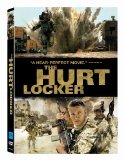It is the last month-and-a-bit of Delta Company’s tour of duty in Iraq. The IED disposal squad has just lost its leader, and he is replaced by Staff Sergeant James (Jeremy Renner), a brilliant bomb defuser who is also something of a loose cannon, prone to taking foolish risks. What follows is Kathryn Bigelow’s best movie to date, as finger-gnawing scenes of bomb disposal and combat alternate with portraits of men’s psyches being taken apart by war, both because of what happens to them, and because of what they must do.
The best Iraq war film to date is also, interestingly, fairly apolitical. It takes no real stand on the whys and wherefores of the conflict, and despite the fact that the incidents are very much specific to the situation in Iraq, the theme of the film – the toll war takes on the men who fight it – would be just as true in a WWI setting. James is an intriguing character, one that it is difficult to wholly like or dislike. He is astoundingly good at what he does, yet he puts the lives of his squad mates in jeopardy. He believes in doing the right thing, and yet, in a speech he makes to his infant son (a scene that is the most heartbreaking of the film), he shows how he has been transformed into a specialized machine, unfit for any society other than that of war. This is a powerful film, then, as thoughtful as it is intense. That intensity, however, does come at a certain cost. We are made to feel the paranoia experienced by the soldiers in the visceral way imaginable, but what this does mean is a dehumanization of the Other. The Iraqis, with very few exceptions, come across as unknowable, mysterious, sinister presences, and while this is very likely true to the experience of the point-of-view characters, it does mean that this is another war film that (inevitably, perhaps?) grants us access to the humanity (in its positive AND negative facets) of only one side of the conflict.
Video
A very striking picture, one that is very true to the theatrical experience of this film. The colours, though naturalistic, also have a hot, parching intensity, thanks in no small part to the surgical-blade sharpness of the image. Contrasts and blacks are also superb, and there is nary a trace of grain or image enhancement in sight. A sterling transfer, by just about standard. The aspect ratio is 1.78:1 anamorphic, which is close enough to the original 1.85:1 to get a pass.
Audio
Here, too, the work is excellent. The surround aspects are tremendous, the superb front-rear and left-right separation and placement of the sound effects plunging one into the midst of the chaos of war. Dialogue is never obscured, however, nor does it every suffer any distortion. The music is properly thunderous, climaxing in the superb use of Ministry in the closing shot.
Commentary Track: This features Bigelow and writer Mark Boal. Their exchange is thoughtful, articulate and interesting, and touches equally on what they were setting out to achieve, how they did it, and what inspired it (specifically Boal’s experiences as an embedded journalist in Iraq).
Special Features
The Hurt Locker: Behind the Scenes: (12:29) A pretty solid featurette, as these promotional pieces go. It does, though, have much of the same information as the commentary track.
Image Gallery with Optional Q&A: (23:21) The pictures are accompanied by the talk given by Bigelow and Boal at the Institute of Contemporary Art in London. This, too, covers a lot of the same ground as the featurette and the commentary track. This might be unavoidable, but it does mean we get a lot of the same stuff three times over.
Trailers.
Final Thoughts
Though there is repetition in the features, don’t let that steer you away from one of the best war movies to come down the pike in a considerable while.







01/23/2010 @ 3:51 pm
I am not usually into a war genre, but I have heard great reviews for this film so I am going to rent it from Redbox and see if it is all that.